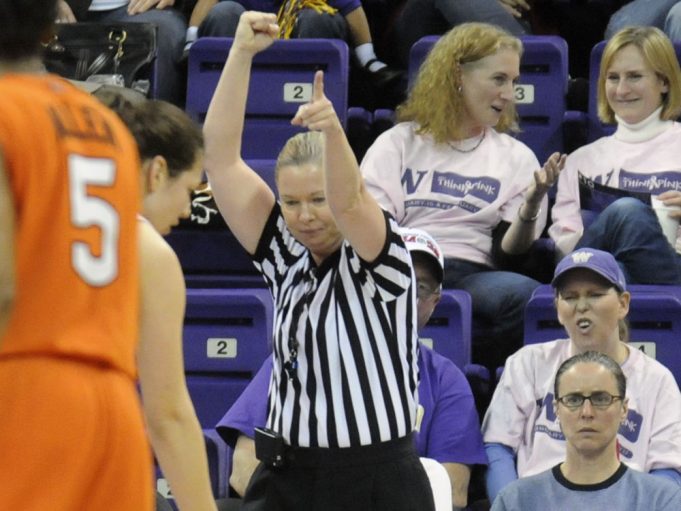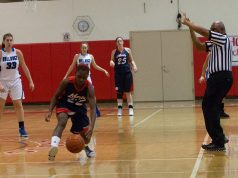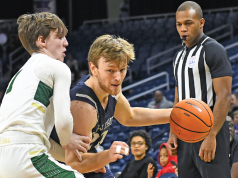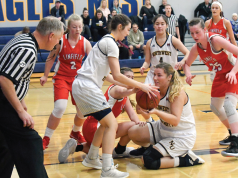There are those who proclaim that the block/charge call is the most difficult in basketball. Consistently getting traveling rulings right at the end of a dribble with rapidly moving players in congested areas is much more difficult. That situation also occurs much more often than the block/charge situation.
Fundamentals.
To judge traveling accurately, you need to see both the ball and the feet. Consider the uncontested layup, for example. The player will leap and catch the ball with both feet off the floor. One foot then lands and the player takes a long stride, landing on the opposite foot, and leaps for the layup: a rhythmic one-two sequence. The first foot to hit the floor is the pivot foot, which can be lifted legally before releasing the ball on a try.
Now consider the case in which the player catches the ball to end the dribble with one foot on the floor. That foot is the pivot foot and cannot be returned to the floor before the ball is released. In that case, the normal one-two rhythm described above is illegal. The key element is the position of the feet at the instant the player catches the ball to end the dribble.
Situations.
The Eurostep is a favorite move these days. It occurs when a player ending a dribble steps at an angle to one side of the straight path of his or her dribble, followed by a leap off that foot to the other side of that straight path, landing on the opposite foot and normally rising for a try (or a pass). If one foot is on the floor when the player catches the ball, it is a traveling violation when that foot returns to the floor.
The spin move is also popular. Focus on the foot that corresponds to the direction of the player’s spin to see if it returns to the floor before the ball is released. For example, if a player spins to the left, focus on the left foot. Often the pivot foot must be replanted to gain the balance needed to rise for the try.
Find the place where you can see the feet
To complicate matters a little more, in the midst of the spin it is also possible for the player to catch the ball with both feet off the floor. He or she may then legally use the one-two sequence described above. If both feet land simultaneously, or if both feet are on the floor at the end of his dribble, he or she may step with either foot, lift the other (the pivot) and rise for the shot legally.
A player might use a crossover move at the end of the spin provided that the restrictions on movement of the pivot foot are met. For example, the player could legally step with his or her left foot as the player completes the pivot, push off that foot to step back to the right with his or her left foot, leap to shoot or pass.
The jump stop.
The rules provide one situation where a player may lift his or her pivot foot and return it to the floor without penalty. A player who is moving may catch the ball with one foot on the floor, or land on one foot if airborne, and leap off that foot to land on both feet simultaneously. The player may not pivot thereafter, but may rise to shoot or pass. If the player has not yet dribbled, he or she must release the ball to the floor before either foot leaves the floor.
The key point is that both feet must land simultaneously. The feet do not have to be the same distance from the basket and there is no limitation on the distance covered in the leap. However, if a player leaps off one foot, lands on the other, and then the first foot returns to the floor, it is a traveling violation. The officials have just a split second to determine whether the foot action is legal, particularly if the player goes on to leap off the pivot foot for a try.
Practical guide.
Find the place where you can see the location of the feet at the instant the dribbler catches the ball. If either foot is on the floor at that moment, it cannot be lifted and returned to the floor before the ball is released. If both feet are off the floor at that time, the one-two and rise action of the uncontested layup sequence is legal.
What's Your Call? Leave a Comment:
Note: This article is archival in nature. Rules, interpretations, mechanics, philosophies and other information may or may not be correct for the current year.
This article is the copyright of ©Referee Enterprises, Inc., and may not be republished in whole or in part online, in print or in any capacity without expressed written permission from Referee. The article is made available for educational use by individuals.


















